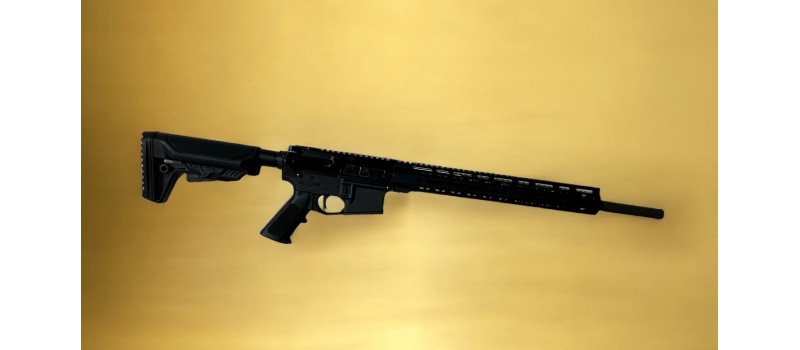Understanding AR Rifle Sighting is crucial for improving your shooting accuracy and performance. When it comes to AR style rifles, there are a few key factors to consider. Firstly, you need to familiarize yourself with the different types of sights available for your rifle, such as iron sights, red dot sights, or magnified optics. Each type has its advantages and disadvantages, so it's essential to choose the one that suits your shooting style and preferences.
Next, you need to understand how the sights work in conjunction with your rifle's barrel length and bullet trajectory. This will help you determine the appropriate distance to zero in your sights for optimal accuracy. Different ammunition types and bullet weights may also affect the trajectory, so it's important to choose the right ammunition for your specific AR rifle.
Additionally, understanding AR Rifle Sighting involves mastering the basic principles of marksmanship, including proper stance, grip, and trigger control. By maintaining a stable shooting platform and consistently pulling the trigger, you can achieve more accurate shots.
Tools Required for Sight-in Process
To ensure that you can properly sight in your AR rifle, there are a few essential tools that you'll need. First and foremost, you'll need a reliable rifle rest or shooting bench. This will provide a stable platform for your rifle, allowing you to make precise adjustments to your sights. Look for a rest that offers stability and adjustability, such as those offered by Vortex or other reputable brands.
In addition to a shooting rest, you'll also need a good quality optic or set of iron sights. If you prefer optics, consider investing in a red dot sight or a magnified optic, depending on your shooting style and preferences. Iron sights can also be highly effective and offer a more traditional shooting experience.
To make adjustments to your sights, you'll need a set of tools such as an Allen wrench or screwdriver, depending on the type of sights you're using. It's important to have the correct tools on hand to avoid damaging your sights or rifle.
Lastly, it's always a good idea to have a shooting mat or pad to provide comfort and protection while you're sighting in your rifle. This will help prevent fatigue and ensure that you can focus on your shots without distraction.
Choosing the Right Ammunition for Your AR Rifle
Choosing the right ammunition for your AR rifle is a crucial aspect of achieving optimal performance and accuracy. With a wide variety of options available, it can be overwhelming to make the right choice. However, by considering a few key factors, you can select the ammunition that best suits your AR rifle.
Firstly, it's important to determine the purpose of your shooting. Are you using your AR rifle for target practice, home defense, or competition shooting? Different ammunition types are designed for specific purposes, such as hollow point for self-defense or match-grade for precision shooting.
Next, consider the bullet weight that is appropriate for your AR rifle. Heavier bullets tend to have better long-range accuracy, while lighter bullets are generally faster and have less recoil. Consider the twist rate of your rifle's barrel, as this can influence the optimal bullet weight.
Additionally, take into account the specific chambering of your AR rifle. Ensure that you choose ammunition that is compatible with your rifle's chamber dimensions. This will prevent any malfunctions or potential damage to your firearm.
Lastly, keep an eye out for gun deals and discounts on reputable brands like Vortex. This will allow you to save money while still obtaining high-quality ammunition.
Finding the Right Distance to Sight In Your Rifle
When it comes to finding the right distance to sight in your AR rifle, there are a few factors to consider. First and foremost, it's important to determine your shooting purpose. Are you using your AR rifle for close-quarter engagements, medium-range shooting, or long-range precision? This will help determine the optimal distance to zero in your sights.
For AR pistols, the typical engagement distances may be closer, so you may want to zero in your sights at a shorter distance like 25 yards. This allows for better accuracy within the range you are most likely to encounter in self-defense or close-quarters situations.
Proper Stance and Positioning for Accurate Shots
Proper stance and positioning are essential for achieving accurate shots with your AR rifle or pistol. To start, stand with your feet shoulder-width apart and slightly staggered, with your dominant foot slightly back. This provides a stable base and helps absorb recoil. Next, maintain a relaxed but firm grip on your firearm, ensuring your support hand is securely holding the forend or grip. Avoid gripping too tightly, as this can negatively affect your accuracy.
When shouldering your AR pistol or rifle, position the buttstock firmly against your shoulder, creating a solid connection between your body and the firearm. This helps control recoil and ensures consistent shot placement.
Additionally, pay attention to your body alignment. Keep your head upright and aligned with your spine, allowing your eyes to naturally focus on the target. Avoid canting or tilting the firearm, as this can throw off your accuracy.
The Importance of Consistent Trigger Pull
Consistent trigger pull is a critical factor in achieving accurate shots with your AR style rifle. When you squeeze the trigger, any variation in pressure or movement can greatly impact your aim and accuracy. To ensure consistent trigger pull, you need to develop proper finger placement and technique.
One important aspect is finger placement on the trigger. Ideally, you should position the pad of your trigger finger, just before the first joint, on the center of the trigger. This allows for a controlled and even pressure when pulling the trigger.
Additionally, maintaining a smooth and continuous squeeze is key. Avoid jerking or slapping the trigger, as this can cause the rifle to move and result in inaccurate shots. Instead, focus on applying steady and deliberate pressure until the shot breaks.
Consistency in trigger pull can be improved through practice and proper technique. Dry firing exercises can help develop muscle memory and reinforce a consistent trigger pull. Take the time to master this fundamental aspect of shooting, and you'll see a noticeable improvement in your accuracy.
Remember, deals on guns and accessories can often be found, allowing you to upgrade your firearm and enhance your shooting experience. Happy shooting!
Making Adjustments to Your AR Rifle's Sights
Once you have familiarized yourself with the basics of AR rifle sighting, it's time to fine-tune your sights to achieve optimal accuracy. Making adjustments to your AR rifle's sights may seem daunting at first, but with a few simple steps, you'll be able to dial in your shots with ease.
Start by selecting a target at a known distance. This will serve as your reference point for making adjustments. Begin by taking a few shots and observing where your shots are landing in relation to the target. If your shots are consistently off-target, it's time to make some adjustments.
Most AR rifles have adjustable sights that allow you to make both windage (horizontal) and elevation (vertical) adjustments. Depending on the type of sights you have, you may need a screwdriver or an Allen wrench to make these adjustments.
To adjust windage, which is the left or right movement of your shots, turn the windage knob in the direction you want your shots to move. For example, if your shots are consistently hitting to the left of the target, turn the windage knob to the right.
To adjust elevation, which is the up or down movement of your shots, use the elevation knob or screw. Again, turn it in the direction you want your shots to move. For example, if your shots are consistently hitting low, turn the elevation knob to raise the point of impact.
Make small adjustments at a time and continue to shoot and observe the impact until you are satisfied with the accuracy. It's important to keep in mind that changes in ammunition, barrel length, or shooting conditions may require further adjustments.
Fine-Tuning Your Rifle's Sighting through Trial and Error
Fine-tuning your rifle's sighting is an ongoing process that often involves trial and error. No matter how well you understand the basics of AR rifle sighting, there will always be slight variations and factors that can affect your shots. That's why it's important to continually practice and make adjustments to ensure optimal accuracy.
When fine-tuning your rifle's sighting, it's important to keep a few things in mind. Firstly, make small adjustments at a time. Overcompensating with large adjustments can throw off your accuracy and make it harder to pinpoint the exact settings that work for you.
Secondly, pay attention to the feedback your shots give you. If your shots consistently fall to the left, for example, make incremental adjustments to your windage settings in the opposite direction. Keep shooting and observing the impact until you start hitting your target with more accuracy.
Lastly, don't be afraid to experiment with different techniques and settings. Every shooter is different, and what works for someone else may not work for you. Through trial and error, you'll be able to find the sweet spot that maximizes your shooting performance.
So don't get discouraged if you don't achieve perfect accuracy right away. Remember that fine-tuning your rifle's sighting is a process that takes time and practice. Keep adjusting, keep shooting, and keep improving. With patience and persistence, you'll become a master of AR rifle sighting.
Additional Tips and Tricks for Successful AR Rifle Sighting
Now that you have a solid understanding of AR rifle sighting and have mastered the basics, it's time to explore some additional tips and tricks that will take your shooting skills to the next level.
1. Consistency is key: Remember to maintain consistency in all aspects of your shooting, from your stance and grip to your trigger pull. This will help ensure that your shots are as accurate as possible.
2. Use a spotting scope: Investing in a spotting scope can greatly enhance your ability to see your shots and make adjustments. It allows you to zoom in on your target and provides a clear view of where your shots are landing.
3. Practice with different shooting positions: Don't limit yourself to shooting from a benchrest. Experiment with shooting from standing, kneeling, and prone positions. This will help you become more comfortable and versatile in various shooting scenarios.
4. Take advantage of technology: There are many smartphone apps available that can assist you in calculating bullet trajectory, wind drift, and other variables. Utilize these tools to your advantage and make more informed shooting decisions.
5. Continuously monitor and evaluate your equipment: Regularly check the condition of your sights, optic, and ammunition. Make sure they are clean, properly mounted, and in good working order. Any issues or inconsistencies can affect your accuracy.
By incorporating these additional tips and tricks into your shooting routine, you'll be well on your way to becoming a skilled AR rifle shooter. Remember, practice makes perfect, so keep refining your technique and pushing yourself to improve. Happy shooting!





-1x1.jpg)

-1x1.jpg)


